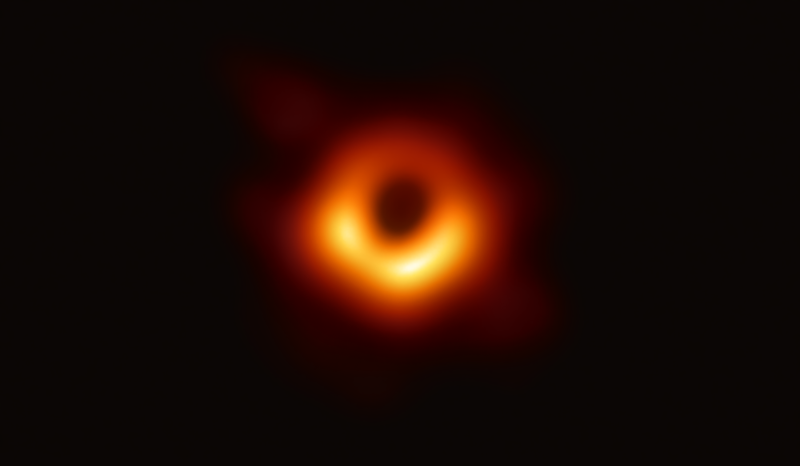
First M87 Event Horizon Telescope Results I. The Shadow of the Supermassive Black Hole
Black hole shadows are revealed because of the gravitational light bending and photon capture and the event horizon. The shadows have a bright emission ring which is detectable through VLBI (very-long baseline interferometer). Black holes have a wide range of masses; for supermassive black holes, their mass can range from millions to tens of billions of solar masses. Factors that can affect the mass of a supermassive black hole include, the spin vector of the black hole, inclination, and size and structure of the emitting region. These supermassive black holes exist in the center of nearly all galaxies, and have the ability to power most AGNs by the hot tenuous accretion flows in the supermassive black holes.
The Very-long-baseline interferometer (VLBI) is able to directly measure the visibilities of radio bright night distribution in the sky. As the earth rotates, each telescope pair in the network samples many spatial frequencies. Because the extension of VLBI requires a wavelength of 1.3 mm or less, there were long technical developments and challenges that were encountered because of the shorter wavelengths.
In 1918, Heber Curtis detected a linear feature in M87, which was later called a “jet” by Basse and Minkowski. This “jet” is seen as a bright radio source. Sources like this are believed to be signatures of supermassive black holes. The scientists also investigated the core shift effect in black holes, which is when the position of a radio core shifts in upstream jet direction with decreasing wavelength. The results from this investigation indicates that the wavelength of 1.3mm M87* is coincident with the super massive black hole.
In April 2017, the M87* was observed by the EHT. During this process, a series of scans of three to seven minutes were carried out, and the number of scans obtained per night ranged from 7 to 25 images. The visibility amplitudes from the collected data were calibrated, and showed a resemblance to thin rings. However, this ring structure is only illustrative and does not fit all features of data recorded, and only represent half the information that was given from the results.
Because of this, scientists then reconstructed the images from EHT data, where they encountered major challenges that were mainly due limitations in different areas. Within each imaging algorithm, there are many free parameters which can affect the final image, which led to scientists using various methods to eliminate biases. The images were also blurred with a circular Gaussian to a common, conservative angular resolution, because the angular resolutions of the constructed images varied among the pipelines. As a result, the team obtained images with features that were broadly consistent across the different imagining methods and across the data collected over the four days.
Using GRMHD simulations, the appearance of M87* was modeled successfully. The simulation was also able to predict the shadow and an asymmetric emission ring. Scientists combined the information contained the Simulation Library and Image Library, and their summary is as follows: The M87* is produced by a magnetized accretion flow orbiting within the event horizon of a Kerr black hole The north-south asymmetry in the emission ring is controlled by the black hole spin and can be used to deduce its orientation adopting an inclination of 17 degrees between the approaching jet and the line of sight, the west orientation of the jet, and a co rotating disk model, matter in the bottom part of the image is rotating clockwise as seen from Earth
As a conclusion, this article shows that the appearance of supermassive black holes and their shadows can now be obtained via electromagnetic waves, through mathematical concepts and repeated astronomical observation techniques.

